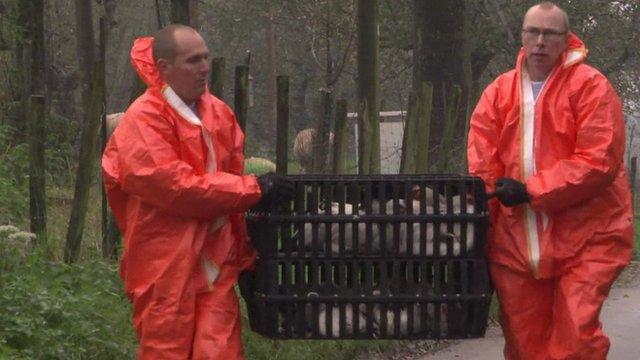Bird flu confirmed at Yorkshire duck farm
- Published
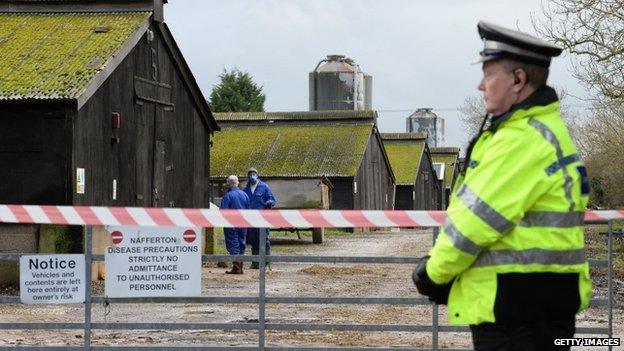
The farmer noticed an increase in mortality among his ducks and contacted the authorities
A case of bird flu has been confirmed at a duck breeding farm in East Yorkshire, officials have said.
The Department for Environment, Food and Rural Affairs (Defra) said the risk to public health was very low and there is not said to be a food safety issue.
Some 6,000 birds will be culled from Tuesday morning and a 10km (6 mile) exclusion zone is in place.
The exact strain has not been confirmed but the H5N1 form, deadly to humans, has been ruled out by Defra officials.
In a statement to the Commons, Environment Secretary Liz Truss said there were tried and tested methods for dealing with the disease, which were "working".
She said there would be compensation paid to farmers adversely affected by the outbreak.
The virus spreads between birds and, in rare cases, can affect humans.
The case is the first in the UK since 2008, when chickens on a farm in Banbury, Oxfordshire tested positive for the virus.
On Sunday, an outbreak of a highly contagious strain of bird flu was discovered at a poultry farm in the Netherlands.
The Dutch government has imposed a three-day nationwide ban on the transportation of poultry and eggs.
Officials say the strain, H5N8, is very dangerous for bird life and could potentially affect humans, although people can only be infected through very close contact with the affected birds.
EU officials, meeting in Brussels, have said the British case is "most likely" linked to the current outbreak in the Netherlands and a recent outbreak in Germany. They also believe migratory birds heading south for winter are responsible.
The exclusion zone around the farm in the village of Nafferton in East Yorkshire prevents all poultry and poultry waste being transferred in or out of the area.
Aerial video of the duck farm affected by bird flu
Farm workers dressed in blue protective overalls and face masks could be seen on the premises, leaving and entering the six low sheds containing the ducks.
Gary Lavis, chairman of Nafferton parish council, said a problem was first noticed about a week ago when egg production began dropping and more ducks were dying.
He said he was particularly concerned about the potential effect on the local wild bird population, with a mere [lake] in the village and an RSPB reserve nearby.
Defra said the flu strain had been identified as the H5 virus, stressing that it was not the H5N1 strain.
A spokeswoman said: "We have confirmed a case of avian flu on a duck breeding farm in Yorkshire - the public health risk is very low and there is no risk to the food chain.
"We are taking immediate and robust action which includes introducing a restriction zone and culling all poultry on the farm to prevent any potential spread of infection."
Public Health England said it was assisting Defra in the investigation.
BBC News health editor Hugh Pym said there has never been a case of human bird flu in northern Europe.

Analysis
By Paul Murphy, environment and rural affairs correspondent, BBC News
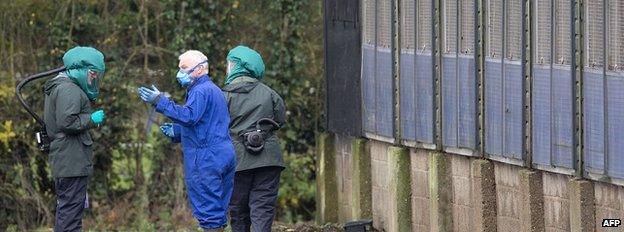
The sight of Defra officials, clad in protective clothing and planning the cull of 6,000 ducks is something no farmer wants to see.
But this community wants this virus stopped in its tracks here at the duck farm in Nafferton.
There are 2.5 million farmed birds in East Yorkshire alone, spread over 50 units. They include 500,000 ducks and more than one million hens. All of them are vulnerable to this highly contagious strain of avian flu.
The six-mile exclusion zone around the infected farm was enforced from first light and could last for weeks. Within the zone the movement of all poultry is completely prohibited - a biosecurity measure which in itself will already be having an impact on local businesses.
But perhaps what will worry farmers most is the suspected source of this outbreak. It is not believed to be the industry's supply chain but rather the droppings of wild birds, migrating in their thousands across Europe, with no regard for exclusion zones and completely beyond anyone's control.

The UK's chief veterinary officer told the BBC it would be a few days before the exact strain would be known.
Chief veterinary officer Nigel Gibbens said the risk of spread was "quite low"
Nigel Gibbens said the disease can be spread when poultry are moved, through the cages used to transport them and the people who work with the birds.
"It can also be spread by the wild bird population and that happens quite regularly," he said.
"There's a number of routes and we are looking to do as much as we can to find out the source and eliminate any further risks."
The farm's bio-security was good, he added, and they were checking other poultry farms within the exclusion zone. But he warned that more cases could follow.
"Because there's a wild bird risk we need farmers and their vets all over the country to be alert to possible disease in their farm that they can't explain, draw those to our attention so we can investigate quickly," he added.
Chris Dickinson, the National Farmers Union county adviser for Yorkshire, said farmers needed to maintain good hygiene measures and check their stock to help prevent a spread.
He said: "It is obviously a worry for poultry farmers but I just ask farmers to keep up high levels of biosecurity and Defra will inform us of their findings in the coming days."
BBC business reporter Chris Johnston said the UK's poultry industry was big business, accounting for 14% of the EU's total production - second only to France.
Chickens make up 93% of the total number of birds reared on British farms, with turkey accounting for 4% and ducks making up just 3%, he added.
British Poultry Council chief executive Andrew Large reiterated the message from scientists that the risk to the general public from bird flu was negligible.
"Consumers should continue to support British poultry meat, assured that there is no risk in eating cooked poultry, and that is a message echoed by the Food Standards Agency and the World Health Organization," he said.

Analysis
by Michelle Roberts, health editor, BBC news website
There are many types of bird flu, and most are harmless to humans. Some strains, like H5N1 and H7N9, can potentially spread from birds to people if there is prolonged close contact.
Even then, the virus is unlikely to spread from person to person and there is no evidence that cooked poultry can infect people.
The ultimate concern is that a bird flu virus will one day mutate and acquire the ability to spread in people.
The most infamous pandemic - the 1918 Spanish flu, which killed millions - probably came from birds.

Prof Wendy Barclay, from Imperial College London, said avian influenza viruses can be "devastating" for the poultry industry.
"Two of the subtypes of avian influenza, H5 and H7, are particularly feared because they can carry unusual sequence motifs that make them highly pathogenic in the birds, killing almost every infected bird in a matter of days," she said.
"Sometimes avian influenza viruses can infect people, so it will be important for those dealing with infected bird carcasses to wear appropriate protective equipment.
"However, only a small subset of avian influenza viruses infect humans. Without undergoing further mutations these infections do not pass from person to person."
Two strains of bird flu, H5N1 and H7N9, have caused serious concern in recent years.
H5N1 has a mortality rate of about 60% within infected humans, according to the World Health Organization. The UN's public health arm recorded 377 deaths from H5N1 in 15 countries by July last year.
H7N9 was first detected in China in 2013 and has led to dozens of deaths.
- Published18 November 2014

- Published17 November 2014
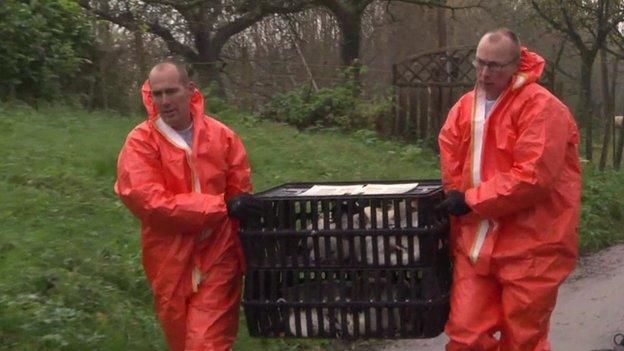
- Published1 May 2013
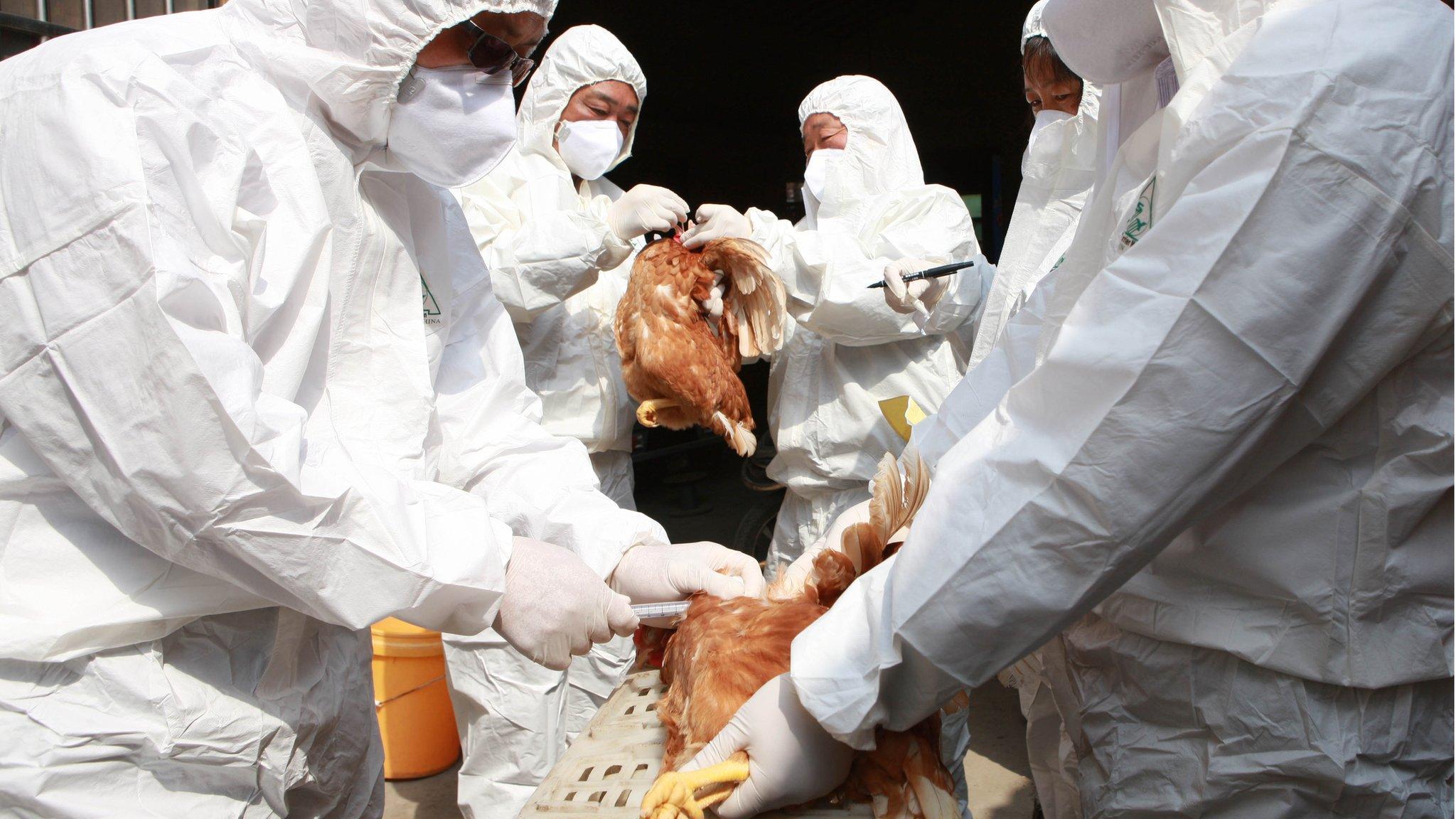
- Published17 November 2014
